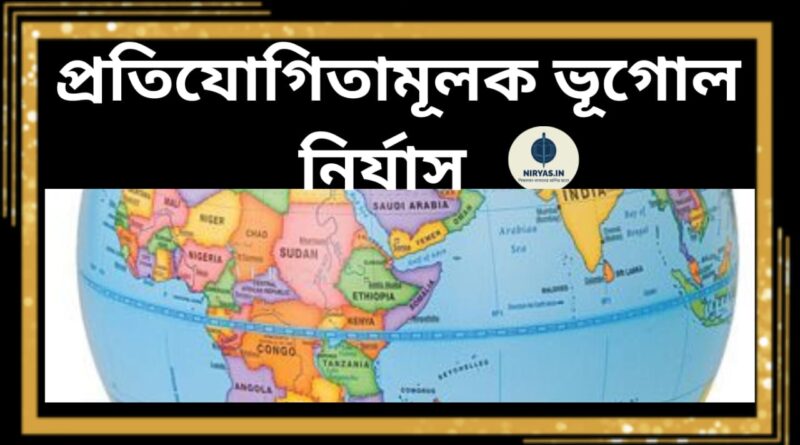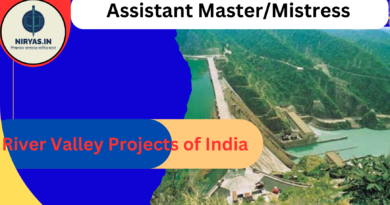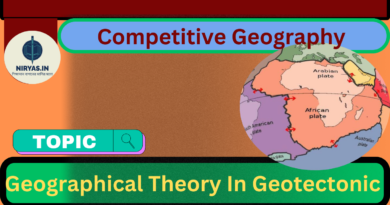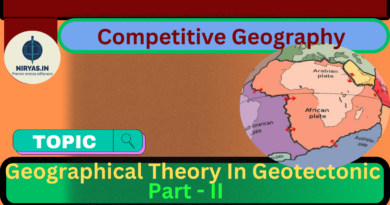Emerging Geographical Terms
Emerging Geographical Terms
প্রতিযোগিতামূলক পরীক্ষার ক্ষেত্রে সাধারণ ভূগোল একটি অতি গুরুত্বপূর্ণ বিষয় । এখান থেকে আসা প্রশ্নগুলির মধ্যে ভৌগোলিক শব্দের প্রথম ব্যবহারের সময়, প্রথম ব্যবহারকারীর নাম ইত্যাদি বিষয়গুলো সমন্ধে জানতে চাওয়া হয় । বর্তমান সংশ্লেষণমূলক MCQ এর উত্তর দেওয়ার জন্য এই তথ্যগুলো অত্যন্ত জরুরী । এই বিষয়টিকে গুরুত্ব দিয়ে Emerging Geographical Terms নামক পোস্টে সমসাময়িককালে ব্যবহৃত ও জনপ্রিয় কিছু ভৌগোলিক শব্দের খুঁটিনাটি তথ্য আলোচনা করা হল ।
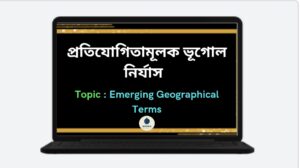
Emerging Geographical Terms
1. গ্লোকালাইজেশন (Glocalization) : গ্লোকালাইজেশন বলতে বিশ্বায়ন এবং স্থানীয় সংস্কৃতির বিচ্ছেদিকরণকে বোঝায়। এই ধারণা অনুযায়ী স্বীকার করা হয় যে, বিশ্বব্যাপী প্রক্রিয়াগুলির স্থানীয় প্রভাব রয়েছে এবং স্থানীয় সংস্কৃতিগুলি বিশ্বব্যাপী ঘটনাকে রূপ দেয়।
2000: রোল্যান্ড রবার্টসন তার বই “গ্লোবালাইজেশন: সোশ্যাল থিওরি অ্যান্ড গ্লোবাল কালচার” এ “গ্লোকালাইজেশন” শব্দটি ব্যবহার করেন।
2005: নীল স্মিথ ও সিন্ডি কাটজের মতো ভূগোলবিদদের কাজের মাধ্যমে ধারণাটি জনপ্রিয়তা লাভ করে।
2010: গ্লোকালাইজেশন বিশ্বব্যাপী এবং স্থানীয় প্রক্রিয়াগুলির মধ্যে জটিল সম্পর্ক বোঝার জন্য একটি মূল ধারণা হয়ে ওঠে।
2. ট্রান্সন্যাশনালিজম (Transnationalism) : ট্রান্সন্যাশনালিজম বলতে বোঝায় জাতীয় সীমানা জুড়ে মানুষ এবং স্থানের মধ্যবর্তী সংযোগকে । এটি আন্তর্জাতিক অভিবাসন, বাণিজ্য এবং যোগাযোগের গুরুত্ব তুলে ধরে।
1990: আলেজান্দ্রো পোর্টেস ও লুইস গুয়ারনিজোর মতো পণ্ডিতদের কাজের মাধ্যমে ধারণাটি উদ্ভূত হয়।
2000: মাইকেল পিটার স্মিথ ও লুইস এডুয়ার্ডো গুয়ারনিজো’র “নীচ থেকে ট্রান্সন্যাশনালিজম” (Transnationalism from Below) বইটি প্রকাশিত হয়।
2010-এর দশক: ভূগোল, সমাজবিজ্ঞান এবং নৃতত্ত্বের গবেষণার একটি মূল ক্ষেত্র হয়ে ওঠে ট্রান্সন্যাশনালিজম।
3. উত্তর-উপনিবেশবাদ (Postcolonialism) : উত্তর-ঔপনিবেশিকতা বলতে আধুনিক সমাজে উপনিবেশবাদের উত্তরাধিকারের অধ্যয়নকে বোঝায়। এটি ঔপনিবেশিক এবং উপনিবেশিত জনগণের মধ্যে ক্ষমতার সম্পর্কের সমালোচনা করে।
1990: ধারণাটি এডওয়ার্ড সাইদ, গায়ত্রী চক্রবর্তী স্পিভাক এবং হোমি ভাবার মতো পণ্ডিতদের কাজের মাধ্যমে উদ্ভূত হয়।
2000: রবার্ট ইয়ং-এর “পোস্টকলোনিয়ালিজম: অ্যান হিস্টোরিক্যাল ইন্ট্রোডাকশন” বইটি প্রকাশিত হয়।
2010-এর দশক: উত্তর-ঔপনিবেশিকতা ভূগোল, সমাজবিজ্ঞান এবং সাংস্কৃতিক অধ্যয়নের মূল দৃষ্টিকোণ হয়ে ওঠে।
4. সমালোচনামূলক ভূগোল (Critical Geography) : সমালোচনামূলক ভূগোল বলতে এমন একটি দৃষ্টিকোণকে বোঝায় যা ক্ষমতার সম্পর্ক এবং সামাজিক ন্যায়বিচারের সমালোচনা করে। এটি ভৌগলিক ঘটনার সামাজিক ও অর্থনৈতিক প্রেক্ষাপট বোঝার গুরুত্বের ওপর জোর দেয়।
1990: ধারণাটি ডেভিড হার্ভে, নীল স্মিথ এবং সিন্ডি কাটজের মতো পণ্ডিতদের কাজের মাধ্যমে উদ্ভূত হয়।
2000: ডেভিড হার্ভির “ভূগোল এবং সামাজিক ন্যায়বিচার” বইটি প্রকাশিত হয়।
2010-এর দশক: জটিল ভূগোলে ভদ্রতা, অসমতা এবং পরিবেশগত ন্যায়বিচারের মতো বিষয়গুলি বোঝার ক্ষেত্রে একটি মূল দৃষ্টিকোণ হয়ে ওঠে।
5. নারীবাদী ভূগোল (Feminist Geography) : নারীবাদী ভূগোল বলতে লিঙ্গ এবং স্থানের মধ্যে সম্পর্কের অধ্যয়নকে বোঝায়। এটি ভৌগলিক ঘটনার সামাজিক ও সাংস্কৃতিক প্রেক্ষাপট বোঝার গুরুত্ব তুলে ধরে।
1990 এর দশক: ডোরেন ম্যাসি, লিন্ডা ম্যাকডোয়েল ও গিলিয়ান রোজের মতো পণ্ডিতদের কাজের মাধ্যমে ধারণাটি উদ্ভূত হয়।
2000: পামেলা মস ও কারেন ফ্যালকনার আল-হিন্দির “ফেমিনিস্ট জিওগ্রাফি ইন প্র্যাকটিস” বইটি প্রকাশিত হয়।
2010-এর দশক: নারীবাদী ভূগোল লিঙ্গ বৈষম্য, গার্হস্থ্য সহিংসতা এবং প্রজনন অধিকারের মতো বিষয়গুলি বোঝার ক্ষেত্রে গবেষণার একটি মূল ক্ষেত্র হয়ে ওঠে।
6. নিওলিবারেলিজম (Neoliberalism) : নিওলিবারেলিজম বলতে বোঝায় অর্থনৈতিক নীতির একটি সেটকে, যা বাজার নিয়ন্ত্রণ, বেসরকারিকরণ এবং বিশ্বায়নের উপর জোর দেয়।
1980 এর দশক: মিল্টন ফ্রিডম্যান ও ফ্রেডরিখ হায়েকের মতো অর্থনীতিবিদদের কাজের মাধ্যমে ধারণাটি উদ্ভূত হয়।
1990: নিওলিবারেলিজম বিশ্বব্যাপী একটি প্রভাবশালী অর্থনৈতিক মতাদর্শে পরিণত হয়।
2010-এর দশক: ডেভিড হার্ভে ও নীল স্মিথের মতো ভূগোলবিদরা বৈষম্য এবং পরিবেশগত অবক্ষয়কে বাড়িয়ে তোলার জন্য নব্য উদারনীতির সমালোচনা করেন।
7. স্থিতিশীল উন্নয়ন (Sustainable Development) : স্থিতিশীল উন্নয়ন বলতে অর্থনৈতিক প্রবৃদ্ধিকে বোঝায়, যা ভবিষ্যৎ প্রজন্মের ক্ষতি না করে বর্তমান চাহিদা পূরণ করে।
1987: ব্রুন্ডল্যান্ড কমিশন তার “আমাদের সাধারণ ভবিষ্যত” (“Our Common Future”) প্রতিবেদনে স্থিতিশীল উন্নয়ন বিষয়টিকে সংজ্ঞায়িত করে।
1992: পরিবেশ ও উন্নয়ন সম্পর্কিত জাতিসংঘ সম্মেলন (রিও আর্থ সামিট) স্থিতিশীল উন্নয়নকে একটি মূল নীতি হিসাবে গ্রহণ করে।
2010-এর দশক: জলবায়ু পরিবর্তন এবং জীববৈচিত্র্যের ক্ষতির মতো পরিবেশগত সমস্যা বোঝার ক্ষেত্রে স্থিতিশীল উন্নয়ন একটি মূল ধারণা হয়ে ওঠে।
8. অ্যানথ্রোপোসিন (Anthropocene): বর্তমান ভূতাত্ত্বিক যুগকে বর্ণনা করার জন্য পল ক্রুটজেন ও ইউজিন স্টোমার এই দুই ভৌগোলিক দ্বারা শব্দটি ব্যবহার করা হয়, যার দ্বারা পরিবেশের উপর উল্লেখযোগ্যভাবে মানবিক প্রভাবকে চিহ্নিত করা হয়েছে।
2000: ক্রুটজেন ও স্টোমার তাদের “The Anthropocene” নামক গবেষণাপত্র IGBP নিউজলেটার জার্নালে প্রকাশ করে।
2016: অ্যানথ্রোপোসিন ওয়ার্কিং গ্রুপ আনুষ্ঠানিকভাবে অ্যানথ্রোপোসিনকে ভূতাত্ত্বিক যুগ হিসাবে স্বীকৃতি দেওয়ার জন্য ভোট দেয়।
9. মেগাসিটি (Megacity) : 10 মিলিয়নেরও বেশি বাসিন্দা সহ একটি শহরকে বোঝায়।
1990 এর দশক: সাসকিয়া সাসেন ও পিটার হলের মতো শহুরে ভূগোলবিদদের কাজের মাধ্যমে শব্দটি জনপ্রিয়তা লাভ করে।
2018: জাতিসংঘে রিপোর্ট অনুযায়ী বিশ্বব্যাপী 28টিরও বেশি মেগাসিটি বিদ্যমান।
👉 Emerging Geographical Terms
10. জলবায়ু উদ্বাস্তু (Climate Refugee) : জলবায়ু পরিবর্তনের কারণে বাস্তুচ্যুত ব্যক্তিকে বোঝায়।
2007: জলবায়ু পরিবর্তন সংক্রান্ত আন্তঃসরকার প্যানেল (IPCC) রিপোর্ট করেছে যে জলবায়ু পরিবর্তনের ফলে অভিবাসন বৃদ্ধি পাবে।
2018: UNHCR এর অনুমান অনুযায়ী জলবায়ু-সম্পর্কিত বিপর্যয়ের কারণে বার্ষিক 22.5 মিলিয়ন মানুষ বাস্তুচ্যুত হয়।
11. শহুরে তাপ দ্বীপ (Urban Heat Island) : আশেপাশের গ্রামীণ এলাকার তুলনায় উচ্চ তাপমাত্রা সহ বিল্ট-আপ এলাকাগুলিকে বোঝায়।
1990: টিমোথি ওকে ও হাওয়ার্ড ব্রিজম্যানের মতো শহুরে জলবায়ুবিদদের কাজের মাধ্যমে ধারণাটি উদ্ভূত হয়।
2019: একটি গবেষণায় দেখা গেছে যে শহুরে তাপ দ্বীপগুলি তাপপ্রবাহের সময় মৃত্যুর হার বৃদ্ধি করে।
12. ভৌগোলিক তথ্য ব্যবস্থাপনা (Geographic Information System) (1960) : ভূ-স্থানিক তথ্য বিশ্লেষণ ও প্রদর্শনের জন্য একটি যান্ত্রিক পদ্ধতি ।
1967: রজার টমলিনসন দ্বারা প্রথম GIS বিকশিত হয়।
2010s: GIS ব্যাপকভাবে নগর পরিকল্পনা, জরুরী প্রতিক্রিয়া, এবং পরিবেশ ব্যবস্থাপনায় ব্যবহৃত হয়।
13. ভার্চুয়াল গ্লোব (Virtual Globe) : পৃথিবীর একটি ডিজিটাল উপস্থাপনা, যেমন গুগল আর্থ।
2001: Keyhole, Inc. প্রথম ভার্চুয়াল গ্লোব সফ্টওয়্যার প্রকাশ করে।
2005: গুগল কীহোল অধিগ্রহণ করে এবং গুগল আর্থ চালু করে।
14. নিওজিওগ্রাফি (Neogeography) : ভৌগলিক তথ্য তৈরি এবং ভাগ করতে ডিজিটাল প্রযুক্তির ব্যবহার।
2006: শব্দটি ভূগোলবিদ অ্যান্ড্রু টার্নার দ্বারা তৈরি করা হয়।
2010: নিওজিওগ্রাফি ভূগোল ও নগর পরিকল্পনায় গবেষণার একটি মূল ক্ষেত্র হয়ে ওঠে।
15. অবস্থান-ভিত্তিক পরিষেবা (Location-Based Services : LBS) : এটি একটি এমন পরিষেবা যা ব্যবহারকারীর অবস্থানের উপর ভিত্তি করে তথ্য প্রদান করে।
2000: নোকিয়া প্রথম এলবিএস চালু করে।
2010: এলবিএস নেভিগেশন, বিজ্ঞাপন এবং সামাজিক মিডিয়াতে ব্যাপকভাবে ব্যবহৃত হয়।
16. ভূ-স্থানিক বুদ্ধিমত্তা (Geospatial Intelligence) : জাতীয় নিরাপত্তা এবং প্রতিরক্ষার জন্য ভূ-স্থানিক তথ্য বিশ্লেষণ।
2003: US National Geospatial-Intelligence Agency (NGA) প্রতিষ্ঠিত হয়।
2010-এর দশক: ভূ-স্থানীয় বুদ্ধিমত্তা ভূগোল এবং জাতীয় নিরাপত্তা গবেষণার একটি মূল ক্ষেত্র হয়ে ওঠে।
17. পরিবেশগত ন্যায়বিচার (Environmental Justice) : পরিবেশগত সুবিধা ও বোধগম্যতার ন্যায্য বন্টন।
1987: জাতিগত বিচারের জন্য ইউনাইটেড চার্চ অফ ক্রাইস্ট কমিশন “মার্কিন যুক্তরাষ্ট্রে বিষাক্ত বর্জ্য এবং জাতি” (“Toxic Wastes and Race in the United States”) নামক গ্রন্থ প্রকাশ করে।
2010 এর দশক: পরিবেশ, স্বাস্থ্য এবং সামাজিক ন্যায়বিচারের মধ্যে সম্পর্ক বোঝার ক্ষেত্রে পরিবেশগত ন্যায়বিচার একটি মূল ধারণা হয়ে ওঠে। ➲ পরবর্তী অংশ
⟽ পূর্ববর্তী পোস্ট : শীর্ষস্থানীয় প্রযুক্তি কোম্পানি
♦️ইবুক : উচ্চ মাধ্যমিক ভূগোল নির্যাস : একাদশ, প্রথম সেমিস্টার
♦️ইবুক : উচ্চ মাধ্যমিক ভূগোল নির্যাস : একাদশ, দ্বিতীয় সেমিস্টার)
Emerging Geographical Terms in English
1. Glocalization (2000s) : Glocalization refers to the intersection of globalization and local cultures. It recognizes that global processes have local impacts and that local cultures shape global phenomena.
2000: Roland Robertson coins the term “glocalization” in his book “Globalization: Social Theory and Global Culture”.
2005: The concept gains popularity through the work of geographers like Neil Smith and Cindi Katz.
2010s: Glocalization becomes a key concept in understanding the complex relationships between global and local processes.
2. Transnationalism (1990s) : Transnationalism refers to the connections between people and places across national borders. It highlights the importance of international migration, trade, and communication.
1990s: The concept emerges through the work of scholars like Alejandro Portes and Luis Guarnizo.
2000: The book “Transnationalism from Below” by Michael Peter Smith and Luis Eduardo Guarnizo is published.
2010s: Transnationalism becomes a key area of research in geography, sociology, and anthropology.
3. Postcolonialism (1990s) : Postcolonialism refers to the study of the legacy of colonialism on modern societies. It critiques the power relationships between colonizers and colonized peoples.
1990s: The concept emerges through the work of scholars like Edward Said, Gayatri Chakravorty Spivak, and Homi Bhabha.
2000: The book “Postcolonialism: An Historical Introduction” by Robert Young is published.
2010s: Postcolonialism becomes a key perspective in geography, sociology, and cultural studies.
4. Critical Geography (1990s) : Critical geography refers to a perspective that critiques power relationships and social justice. It emphasizes the importance of understanding the social and economic contexts of geographical phenomena.
1990s: The concept emerges through the work of scholars like David Harvey, Neil Smith, and Cindi Katz.
2000: The book “Geography and Social Justice” by David Harvey is published.
2010s: Critical geography becomes a key perspective in understanding issues like gentrification, inequality, and environmental justice.
5. Feminist Geography (1990s) : Feminist geography refers to the study of the relationships between gender and space. It highlights the importance of understanding the social and cultural contexts of geographical phenomena.
1990s: The concept emerges through the work of scholars like Doreen Massey, Linda McDowell, and Gillian Rose.
2000: The book “Feminist Geography in Practice” by Pamela Moss and Karen Falconer Al-Hindi is published.
2010s: Feminist geography becomes a key area of research in understanding issues like gender inequality, domestic violence, and reproductive rights.
6. Neoliberalism (1980s) : Neoliberalism refers to a set of economic policies that emphasize market deregulation, privatization, and globalization.
1980s: The concept emerges through the work of economists like Milton Friedman and Friedrich Hayek.
1990s: Neoliberalism becomes a dominant economic ideology globally.
2010s: Geographers like David Harvey and Neil Smith critique neoliberalism for exacerbating inequality and environmental degradation.
7. Sustainable Development (1987) : Sustainable development refers to economic growth that meets present needs without harming future generations.
1987: The Brundtland Commission defines sustainable development in its report “Our Common Future”.
1992: The United Nations Conference on Environment and Development (Rio Earth Summit) adopts sustainable development as a key principle.
2010s: Sustainable development becomes a key concept in understanding environmental issues like climate change and biodiversity loss.
8. Anthropocene (2000) : Coined by Paul Crutzen and Eugene Stoermer to describe the current geological epoch, characterized by significant human impact on the environment.
2000: Crutzen and Stoermer publish their paper “The Anthropocene” in the journal IGBP Newsletter.
2016: The Anthropocene Working Group votes to formally recognize the Anthropocene as a geological epoch.
9. Megacity (1990s) : Refers to a city with over 10 million inhabitants.
1990s: The term gains popularity through the work of urban geographers like Saskia Sassen and Peter Hall.
2018: The United Nations reports that over 28 megacities exist worldwide.
✒ Emerging Geographical Terms
10. Climate Refugee (2000s) : Refers to a person displaced due to climate change.
2007: The Intergovernmental Panel on Climate Change (IPCC) reports that climate change will lead to increased migration.
2018: The UNHCR estimates that 22.5 million people are displaced annually due to climate-related disasters.
11. Urban Heat Island (1990s) : Refers to built-up areas with higher temperatures than surrounding rural areas.
1990s: The concept emerges through the work of urban climatologists like Timothy Oke and Howard Bridgman.
2019: A study finds that urban heat islands increase mortality rates during heatwaves.
12. Geographic Information System (GIS) (1960s) : A tool for analyzing and displaying geospatial data.
1967: The first GIS is developed by Roger Tomlinson.
2010s: GIS becomes widely used in urban planning, emergency response, and environmental management.
13. Virtual Globe (2000s) : A digital representation of the Earth, like Google Earth.
2001: Keyhole, Inc. releases the first virtual globe software.
2005: Google acquires Keyhole and launches Google Earth.
14. Neogeography (2000s) : The use of digital technologies to create and share geographic information.
2006: The term is coined by geographer Andrew Turner.
2010s: Neogeography becomes a key area of research in geography and urban planning.
15. Location-Based Services (LBS) (2000s) : Services that provide information based on a user’s location.
2000: The first LBS is launched by Nokia.
2010s: LBS becomes widely used in navigation, advertising, and social media.
16. Geospatial Intelligence (2000s) : The analysis of geospatial data for national security and defense.
2003: The US National Geospatial-Intelligence Agency (NGA) is established.
2010s: Geospatial intelligence becomes a key area of research in geography and national security.
17. Environmental Justice (1980s) : The fair distribution of environmental benefits and burdens.
1987: The United Church of Christ Commission for Racial Justice publishes “Toxic Wastes and Race in the United States”.
2010s: Environmental justice becomes a key concept in understanding the relationships between environment, health, and social justice.➲ Next Part
